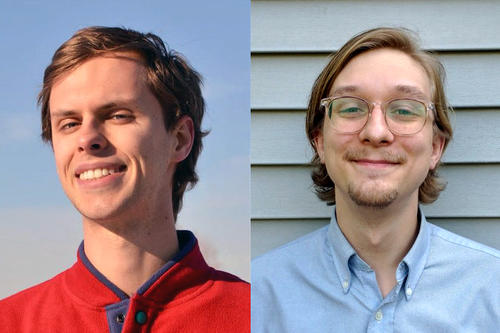
What’s the size of a shoebox and travels at five times the speed of sound (Mach 5)? Answer: small “cube” satellites (CubeSats) that are revolutionizing near-Earth space studies—with a little help from U of M students.
“There was one thing I wanted to do in the future, and it was work for NASA,” says senior Per Jorgenson, a physics major in the College of Science and Engineering.
Last summer Jorgenson fulfilled that dream during a virtual internship with the NASA Ames Research Center. He worked on research related to the U of M’s Small Satellite Research Laboratory, along with aerospace graduate students Alex Hayes and Nathaniel Anderson. Two other aerospace engineering graduate students—Eric Geistfeld and Zachary Johnston—had NASA internships in a related area, the common thread being studies of hypersonic vehicular flight (Mach 5 or faster).
Space science in their own space
Researchers in the Small Satellite Lab plan to launch a CubeSat-like vehicle and deliberately de-orbit it to study what happens when it tumbles back to Earth at hypersonic speed, transmitting data as it falls. NASA has similar interests, so the agency tasked Jorgenson with finding a way to record data from a satellite as it burned up in the atmosphere. He used a modem from the satellite communication company Iridium—essentially using phone signals to transmit data from the satellite to the ground.
Johnston spent his internship studying how the geometry of a space capsule affects its stability during free flight, and Geistfeld simulated molecular collisions involving the surrounding medium that accompany hypersonic flight. Geistfeld’s work will help scientists understand how these collisions, or chemical reactions among molecules, affect the vehicle, which could help NASA select designs and materials for future space missions.
“Sometimes there are so many reactions happening that the cloud around your space vehicle blocks radio transmissions,” Geistfeld notes. “That happens to capsules landing on Mars, for example. You need this fundamental understanding of the chemical reactions to start looking at problems like that and make accurate predictions to keep your space capsule safe.
“My advisor worked at NASA shortly after people had landed on the moon. I was awestruck just getting to work with him. It was a really great experience.”
“Our hope here at the U of M with the Small Satellite group is to work with NASA in parallel,” Jorgenson says. “It benefits us for our research purposes with HyCUBE [the U of M’s Hypersonic Configurable Unit Ballistic Experiment] and also they’re looking at using it to further their own projects.”
Read more about these high-aiming students.
- Categories:
- Science and Technology
- Physics and Astronomy
- Research
- Science





